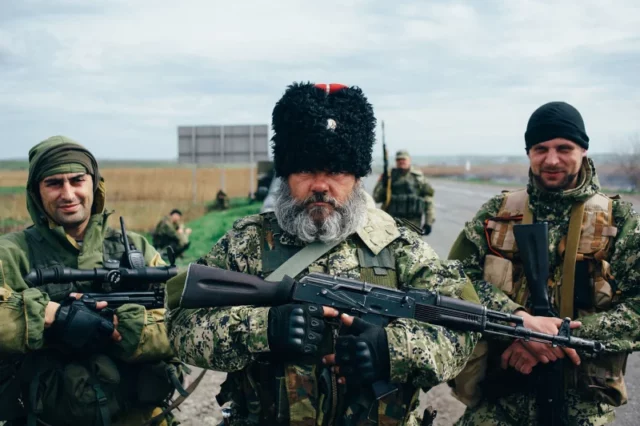
The Ghosts of ‘Taras Bul’ba’
Publication: Eurasia Daily Monitor Volume: 19 Issue: 160
By:

A recently completed investigation demonstrates that the main goal of the Russian-forced re-location of Ukrainian children to Russia is so they can be raised to value their “true” heritage, which has drawn the ire of Kyiv (Ukrainian.voanews.com, October 22). The shared cultural heritage of Russia and Ukraine forms the ostensible justification for Russian President Vladimir Putin’s re-invasion of Ukraine—that Ukrainians are really Russians who have forgotten (or been lured away by Western corruption) their “true” identity. One such shared common legacy is that of the Cossacks who have their spiritual center in (Ukrainian) Zaporizhzhia.
In 2009, director Vladimir Bortko produced a movie adaptation of Nikolai Gogol’s classic novel Taras Bul’ba, which once again raised the question as to whether the author belongs Ukrainian or Russian culture (Radio Svoboda, April 8, 2009). Gogol’s nationality remains capable of motivating people. Indeed, “no one doubts that the Zaporozhzhian Cossacks considered themselves Russians.
This fact was clearly noted by Nikolai Gogol in his famous work Taras Bul’ba. Where is the state of Ukraine here? Previously, the terms ‘Ukraine’ or ‘borderland’ were repeatedly used to refer to the outlying, border territories of Russia, the Muscovite state. In official correspondence, Bohdan Khmelnytsky called himself the hetman of the Zaporizhzhia Army, while calling the lands ‘little Russian’ or ‘Ukrainian’” (Allcossacks.ru, July 26, 2021). Clearly, the common history of the Cossacks in the area plays a key ideological role in Moscow’s naked aggression.
Similarly, both Russian and Ukrainian Cossacks celebrate October 14, the day of the festival of Pokrova (or the Protection of the Most Holy Theotokos) in the Eastern Orthodox calendar. Russian Supreme Ataman Nikolai Doluda claimed that “for the Cossacks, this holiday has always had special meaning. From time immemorial, the Cossacks built temples, performed military feats and won glorious victories,” which he hopes extends to Donbas (Vsko.ru, October 14). In Ukraine, October 14 is the Day of the Ukrainian Cossacks as well as the Day of Ukrainian Defenders. This year it was celebrated publicly with poems and online videos as well as privately by civic Cossack organizations (Tsn.ua, October 14). Thus, numerous cultural similarities remain, which perhaps lend to the ostensible similarity between the cultures, with the proviso that Ukrainian Cossack festivities celebrate society, whereas those of the Russian Cossacks venerate the state.
In the modern era, the Russian state has reconstructed a “service” or “registered” Cossack movement (see EDM, March 2, March 30, April 25, July 25). Although one can question the devotion to actual Cossack history of those who operate within the ranks of the service movement, the Cossack legacy in the region offers insights into the motivations of this small but critical segment of the Russian army. It also offers possibilities for how Russia plans to consolidate its control over the region after the fighting—plans which are speculative at best.
To begin with, the mythical importance of the region to at least some of the Cossacks fighting in Ukraine was spelled out in an interview with the commander of the Tavrida battalion, Ivan Andreev, who goes by the nom de guerre “Horseman” and hails from the Black Sea Cossack Host in illegally annexed Crimea. Andreev claimed that “Zaporizhzhia Oblast is a territory of historical inhabitance by the Cossacks, the Zaporizhzhian Cossacks, [it is] very symbolic that we were here. And it is a great honor for us here and now to liberate this territory. We will go to Zaporizhzhia and Khortytsia. … For the Cossacks, this is a holy war. Because now there is a clear and open war against the Orthodox Christian world. It is obvious. We see how actively on the territory of Ukraine they are fighting with canons of the Orthodox faith, creating sects there, handing out names. For us, this war, in the first instance, is to protect our faith. But in general, this is a war for the protection of the Russian world” (Vsko.ru, September 10).
The proximity of the terms “religious” and “Cossack” is revealing, and the number of Cossacks who have served on the front now stands at 8,000, up from 4,000 in early April 2022 (Vsko.ru, October 13). Given that approximately 700,000–800,000 Cossacks have “registered” in Russia, it remains a mystery why more registered Cossacks have not been called up into the conflict Perhaps, this is because the Russian regime is saving them to suppress domestic dissent?
But the institutionalization of the Cossack legacy has also expanded during the war, including in Ukraine. In a June 2022 article, since removed from the All-Russian Cossack Society website, several dignitaries discussed the idea of creating a 13th voiska for the Russian Cossack society: the Zaporozhzhian voiska. This would certainly be consistent with plans to expand the presence of Cossack voiska in Russian life, such as the plan to create one in Kaliningrad (see EDM, September 12).
Cossack organizations are also planning on expanding youth organizations to Kherson, Zaporizhzhia, Luhansk and Donetsk (Vsko.ru, October 21). Meanwhile, some 27 young Cossacks have sacrificed their lives in the “special military operation,” a number which underscores the calamitous long-term demographic consequences for Russia as it continues to lose military forces at an alarming rate. In this vein, one may ask how much blood Putin is willing to sacrifice on the altar of a criminal invasion in an attempt to exorcize the ghosts of Taras Bul’ba.



